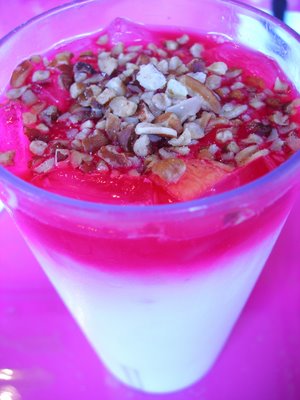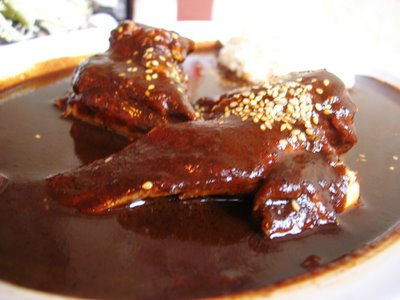
A different take on horchata
What kind of Spanish-speaker, food lover, and aficionada of all things Latin has never tried Oaxacan food, considered by many to be the pinnacle of Mexican cooking?
Me. But not anymore.
The truth is, Mexican food is so heavy--I can hardly think of anything more filling than beans, rice, tortillas, and cheese--that I get full just thinking about it, and off to Sawtelle I go. But my curiosity about moles finally got the better of me.
What better way to start off an unfamiliar experience than with a tried-and-true favorite? Or so I thought. Guelaguetza's horchata con tuna y nuez contains chopped walnuts, a few chunks of canteloupe, and a hot pink syrup that is supposed to taste like prickly pear cactus fruit. I didn't like the drink because it was too cinnamony and the pink syrup tasted like cough syrup. You could probably ask for a plain horchata if you wanted one, though it's not listed on the menu.

Chips and salsa
The mole coloradito on the chips has a sweet, smokey flavor but isn't too spicy. The crumbly cheese doesn't taste like much, but its ultrasoft consistency is pleasant. I wonder why they pour the sauce on top instead of giving you a bowl of it? The problems with the sauce-on-top method are that some chips don't have enough sauce on them, some chips are too messy, the chips get soggy after a while, slower eaters might miss out on all the good, saucy, cheesy chips, and if you're sharing a plate, people have to pick around for chips with the right amount of sauce. Wow-- who knew sauce placement could be so important?

Mole negro con pechuga de pollo
Oaxacan mole traces its roots to the cuisine of the Aztecs, who used many of the same ingredients that are still used in moles today: chiles (of course), vanilla beans, cocoa, jitomate, and a variety of spices. A well-known legend actually credits a nun with the creation of the first mole. There are seven common types of moles: coloradito, rojo, manchamanteles, verde, amarillo, chichilo y negro.
Mole negro is distinguished from the others by its greater complexity. Its ingredients can include multiple types of peppers and their toasted seeds, ginger, onion, jitomate, black pepper, assorted seeds and nuts, avocado leaf, oregano, cumin, cinnamon, chocolate, sugar, salt, and more. While this might sound like a culinary nightmare, the result is actually an incredibly complex sauce that seems to have more in common with Indian or Japanese curries than with what most people think of as Mexican food, as did the meat/sauce/rice trio. Even the presentation of my dish had a Japanese aesthetic.
The mole was spicy, but not exactly hot. Rather than burning my mouth, consecutive bites built up a burning sensation in the back of my throat--but nothing a swig of horchata couldn't fix. The chicken breast was dry, so I'd recommend trying the pierna (leg) or muslo (thigh) instead. I wish it had come with more rice to eat with the mole, but it did come with plenty of corn tortillas.

Not like an Argentinian empanada
In Oaxacan cuisine, an empanada is a large corn tortilla folded in half over any number of fillings. My friend tried the empanada de flor de calabaza, which contained squash blossoms, cheese, and a red mole. He liked the sauce and the fillings, but couldn't quite get used to one of the flavors in the mole. Oaxacan food, while a type of Mexican food, contains many ingredients whose names and flavors are unfamiliar to most of us. It wouldn't hurt to ask around for recommendations on specific dishes or make a cheat sheet of Oaxacan food vocabulary before you dine. Guelaguetza's menu does list a few terms at the top, but the list isn't exhaustive, and flipping back and forth is a pain.

Clayuda vegetariana
A clayuda is a large, thin, crispy tortilla. It is always topped with bean paste and cabbage, but the rest of the toppings can vary. Non-vegetarian versions add a layer of pork fat called aciento to the bean layer and can also have meat toppings. Guelaguetza's clayuda vegetariana was topped with quesillo (Oaxacan string cheese), cabbage, canned button mushrooms, nopales (cactus), cilantro, tomatoes, and black bean paste. Clayuda is sometimes spelled "tlayuda," so if you see a tlayuda on another restaurant's menu, it's the same thing is a clayuda. It's large enough (maybe 14 inches in diameter) to be more than enough food for a meal, but it's commonly eaten as an appetizer or snack food.
My friends were somewhat disappointed by the clayuda, because rather than a crispy tortilla base, which turned out to be rather tough, they were expecting a soft base. Also, the canned mushrooms got old fast. If you aren't a vegetarian then, a better way to go would probably be the clayuda con asiento and your selection quesillo or meat (chorizo-sausage, tasajo-a type of dried, salted beef, or cecina-another dried, salted beef).
Guelaguetza is vegetarian-friendly, with a special menu section containing about ten items.
The restaurant was packed at 6:00, but as the early diners left, few later diners replaced them. You can definitely take your kids here--I saw several families with young children and even babies-- but if you're looking for a quiet meal, Guelaguetza is not it. Even with the restaurant being busy, I had no trouble at all finding a spot in the large parking lot behind the restaurant.
The atmosphere at this location leaves a lot to be desired. There's a TV playing sports games, and the tables awfully close together. The service is minimal--we had to get up to ask for change, and our server seemed hurried and not like someone I felt comfortable asking about the unfamiliar dishes. In the future, I'd prefer to get takeout, if it's offered. Also, I have a feeling the Koreatown or the Downtown locations are more enjoyable--it looks like they have live music, too. At the Palms location, the experience is strictly about the food.
Guelaguetza is often praised for its food, particularly its moles. While I haven't yet tried any other Oaxacan places that I could compare this restaurant to, I still think there's significant room for improvement in every dish.
If you've been to Guelaguetza, how was your experience? Leave a comment!
Guelaguetza
11127 Palms Blvd.
Los Angeles, CA 90034
310-837-1153
Mon-Thur, 9am-10pm
Fri-Sat, 9am-10:30pm
Sun, 9am-9:30pm
Map
Guelaguetza Menu
Website about Oaxaca (in Spanish)
Other locations:
3014 W. Olympic Blvd.
Los Angeles, CA
213-427-0608
3337 1/2 W. 8th St.
Los Angeles, CA
213-427-0601
1 comment:
I haven't been in a while...I usually get the Black Mole dishes....i love those chips with the oaxacan cheese and mole! My favorite is the chicken tamale with the mole negro....don't stray too far...breakfast was disappointing...I guess I'm just not a fan of chorizo.
I like Monte Alban better, although I do like the moles at Gueleguetza better.
Post a Comment